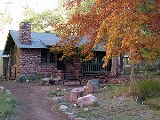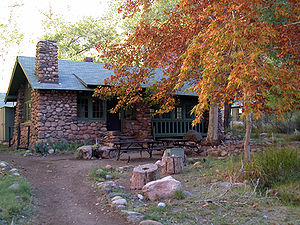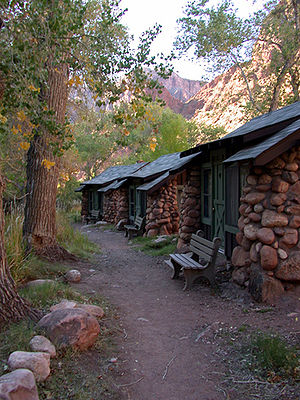
Phantom Ranch
Encyclopedia
Phantom Ranch is a resort village within Grand Canyon National Park
in Arizona
. It is located on the north side of the Colorado River
near its confluence with Bright Angel Creek
and Phantom Creek.

dating from about 1050 have been found there. The earliest recorded visit by Europeans took place in 1869, when John Wesley Powell
and his company camped at its beach. Prospectors began using the area in the 1890s, using mules to haul their ore. At the turn of the century, the founders of the Grand Canyon Transportation Company began a project to exploit its tourism potential; they hired a crew to improve the trail from Phantom Ranch to the Canyon's North Rim. President Theodore Roosevelt
travelled down the canyon to the camp during a hunting expedition in 1913; in honor of this visit, the site became known as Roosevelt Camp.
Roosevelt's enthusiasm for the Grand Canyon helped lead to its incorporation into the National Park System in 1919. The Fred Harvey Company
was granted the concession for the camp in 1922; the company hired the American architect Mary Colter
to design permanent lodging. Mary Colter suggested that its name be changed to Phantom Ranch. Construction presented a major challenge: all the building materials except rock had to be hauled down by mules. Meeting the challenges at this and other national parks led to the architectural style known as National Park Service Rustic
, which features native stone, rough-hewn wood, large-scale design elements, and intensive use of hand labor.
During the Great Depression
in the 1930s, the Civilian Conservation Corps
made a number of improvements to the ranch and its access trails. The 1920s and 1930s saw its popularity grow, and it was visited by many wealthy and notable guests. The Fred Harvey company made it a point to hire young, attractive, well-educated, and adventurous women to staff the resort.
As the Grand Canyon's popularity grew, so did Phantom Ranch's; during the weekend of Easter in 1964, about 1,000 people appeared with the intention of spending the night there. The National Park Service then instituted a permit system for overnight stays at the ranch.
The site now includes cabins, two male and two female dormitories, a restaurant (serving only people who book meals ahead of time), a mule corral, emergency medical facilities, a ranger station, the Bright Angel Campground, a beach that is frequently visited by Colorado River rafters, and a heliport
. Cottonwood trees line the creeks and shade the buildings. The only modes of access to the ranch are foot trails (also used by mules) and the Colorado River. The North Kaibab Trail
leads 14 miles to the North Rim. The 9.3 mile trail to the South Rim follows the River Trail
for two miles and then climbs the Bright Angel Trail
to Grand Canyon Village. The two trail bridges near the ranch are the only Colorado River crossings within a 200-mile distance.
Phantom Ranch also holds the distinction of being one of the only places left in America
whose mail is still delivered by mule, the other being Supai, Arizona
.

at the ranch is subject to invasion by non-native species such as tamarix
, and volunteers are at times invited to help maintain the original biome
by removing them.
The ranch is located at 36°06′18"N 112°05′40"W.
Grand Canyon National Park
Grand Canyon National Park is the United States' 15th oldest national park and is located in Arizona. Within the park lies the Grand Canyon, a gorge of the Colorado River, considered to be one of the Wonders of the World. The park covers of unincorporated area in Coconino and Mohave counties.Most...
in Arizona
Arizona
Arizona ; is a state located in the southwestern region of the United States. It is also part of the western United States and the mountain west. The capital and largest city is Phoenix...
. It is located on the north side of the Colorado River
Colorado River
The Colorado River , is a river in the Southwestern United States and northwestern Mexico, approximately long, draining a part of the arid regions on the western slope of the Rocky Mountains. The watershed of the Colorado River covers in parts of seven U.S. states and two Mexican states...
near its confluence with Bright Angel Creek
Bright Angel Creek
Bright Angel Creek is located at the bottom of the Grand Canyon National Park at the end of the Bright Angel Trail on the north side of the Colorado River.-External links:**...
and Phantom Creek.

History
The site where the ranch is now located was used by Native Americans; pit houses and a ceremonial kivaKiva
A kiva is a room used by modern Puebloans for religious rituals, many of them associated with the kachina belief system. Among the modern Hopi and most other Pueblo peoples, kivas are square-walled and underground, and are used for spiritual ceremonies....
dating from about 1050 have been found there. The earliest recorded visit by Europeans took place in 1869, when John Wesley Powell
John Wesley Powell
John Wesley Powell was a U.S. soldier, geologist, explorer of the American West, and director of major scientific and cultural institutions...
and his company camped at its beach. Prospectors began using the area in the 1890s, using mules to haul their ore. At the turn of the century, the founders of the Grand Canyon Transportation Company began a project to exploit its tourism potential; they hired a crew to improve the trail from Phantom Ranch to the Canyon's North Rim. President Theodore Roosevelt
Theodore Roosevelt
Theodore "Teddy" Roosevelt was the 26th President of the United States . He is noted for his exuberant personality, range of interests and achievements, and his leadership of the Progressive Movement, as well as his "cowboy" persona and robust masculinity...
travelled down the canyon to the camp during a hunting expedition in 1913; in honor of this visit, the site became known as Roosevelt Camp.
Roosevelt's enthusiasm for the Grand Canyon helped lead to its incorporation into the National Park System in 1919. The Fred Harvey Company
Fred Harvey Company
The origin of the Fred Harvey Company can be traced to the 1875 opening of two railroad eating houses located at Wallace, Kansas and Hugo, Colorado on the Kansas Pacific Railway. These cafés were opened by Fred Harvey, then a freight agent for the Chicago, Burlington and Quincy Railroad...
was granted the concession for the camp in 1922; the company hired the American architect Mary Colter
Mary Colter
Mary Elizabeth Jane Colter was an American architect and designer. As a child, Mary Colter traveled with her family through frontier Minnesota, Colorado and Texas in the years after the American Civil War. After her father died in 1886, Colter attended the California School of Design in San...
to design permanent lodging. Mary Colter suggested that its name be changed to Phantom Ranch. Construction presented a major challenge: all the building materials except rock had to be hauled down by mules. Meeting the challenges at this and other national parks led to the architectural style known as National Park Service Rustic
National Park Service Rustic
National Park Service rustic, also colloquially known as Parkitecture, is a style of architecture that arose in the United States National Park System to create buildings that harmonized with their natural environment. Since its founding, the National Park Service consistently has sought to provide...
, which features native stone, rough-hewn wood, large-scale design elements, and intensive use of hand labor.
During the Great Depression
Great Depression
The Great Depression was a severe worldwide economic depression in the decade preceding World War II. The timing of the Great Depression varied across nations, but in most countries it started in about 1929 and lasted until the late 1930s or early 1940s...
in the 1930s, the Civilian Conservation Corps
Civilian Conservation Corps
The Civilian Conservation Corps was a public work relief program that operated from 1933 to 1942 in the United States for unemployed, unmarried men from relief families, ages 18–25. A part of the New Deal of President Franklin D...
made a number of improvements to the ranch and its access trails. The 1920s and 1930s saw its popularity grow, and it was visited by many wealthy and notable guests. The Fred Harvey company made it a point to hire young, attractive, well-educated, and adventurous women to staff the resort.
As the Grand Canyon's popularity grew, so did Phantom Ranch's; during the weekend of Easter in 1964, about 1,000 people appeared with the intention of spending the night there. The National Park Service then instituted a permit system for overnight stays at the ranch.
Phantom Ranch in the 21st century
The ranch continues to be one of the most popular destinations in the national park system; its accommodations are often sold out for a year in advance.The site now includes cabins, two male and two female dormitories, a restaurant (serving only people who book meals ahead of time), a mule corral, emergency medical facilities, a ranger station, the Bright Angel Campground, a beach that is frequently visited by Colorado River rafters, and a heliport
Heliport
A heliport is a small airport suitable only for use by helicopters. Heliports typically contain one or more helipads and may have limited facilities such as fuel, lighting, a windsock, or even hangars...
. Cottonwood trees line the creeks and shade the buildings. The only modes of access to the ranch are foot trails (also used by mules) and the Colorado River. The North Kaibab Trail
North Kaibab Trail
The North Kaibab Trail is a hiking trail in Grand Canyon National Park, located in the U.S. state of Arizona.-Access:Access to this part of the park by car is seasonal, open from mid-May to mid-October or depending on snowcover from the previous winter...
leads 14 miles to the North Rim. The 9.3 mile trail to the South Rim follows the River Trail
River Trail
There are many uses for River Trail:* River Trail , a hiking trail in Grand Canyon National Park, located in the U.S. state of Arizona* Greenbrier River Trail, a hiking and biking rail trail located in the U.S. state of West Virginia...
for two miles and then climbs the Bright Angel Trail
Bright Angel Trail
The Bright Angel Trail is a hiking trail located in Grand Canyon National Park in the U.S. state of Arizona.-Access:The trail is accessed by the mule corral, as seen here:-Description:...
to Grand Canyon Village. The two trail bridges near the ranch are the only Colorado River crossings within a 200-mile distance.
Phantom Ranch also holds the distinction of being one of the only places left in America
United States
The United States of America is a federal constitutional republic comprising fifty states and a federal district...
whose mail is still delivered by mule, the other being Supai, Arizona
Supai, Arizona
Supai is a census-designated place in Coconino County, Arizona, United States, within the Grand Canyon.As of the 1990 census, the CDP had a population of 423; the 2000 census erroneously recorded a population of 0...
.

Geography
Phantom Ranch's elevation is 2,550 feet; that is about 4,600 feet lower than the South Rim and about 5,800 feet lower than the North Rim. The average daily high and low temperatures are 106/78°F (41/25°C) during July and 56/36°F (13/2°C) in January. This represents a wide differential from temperatures at the top of the Grand Canyon; at the South Rim, the average daily high and low temperatures are 84/54°F (29/12°C) in July and 41/18°F (5/-8°C) in January. The South Rim averages 58” (147 mm) of snow, and Phantom Ranch less than 1” (25 mm). The riparian zoneRiparian zone
A riparian zone or riparian area is the interface between land and a river or stream. Riparian is also the proper nomenclature for one of the fifteen terrestrial biomes of the earth. Plant habitats and communities along the river margins and banks are called riparian vegetation, characterized by...
at the ranch is subject to invasion by non-native species such as tamarix
Tamarix
The genus Tamarix is composed of about 50-60 species of flowering plants in the family Tamaricaceae, native to drier areas of Eurasia and Africa...
, and volunteers are at times invited to help maintain the original biome
Biome
Biomes are climatically and geographically defined as similar climatic conditions on the Earth, such as communities of plants, animals, and soil organisms, and are often referred to as ecosystems. Some parts of the earth have more or less the same kind of abiotic and biotic factors spread over a...
by removing them.
The ranch is located at 36°06′18"N 112°05′40"W.

